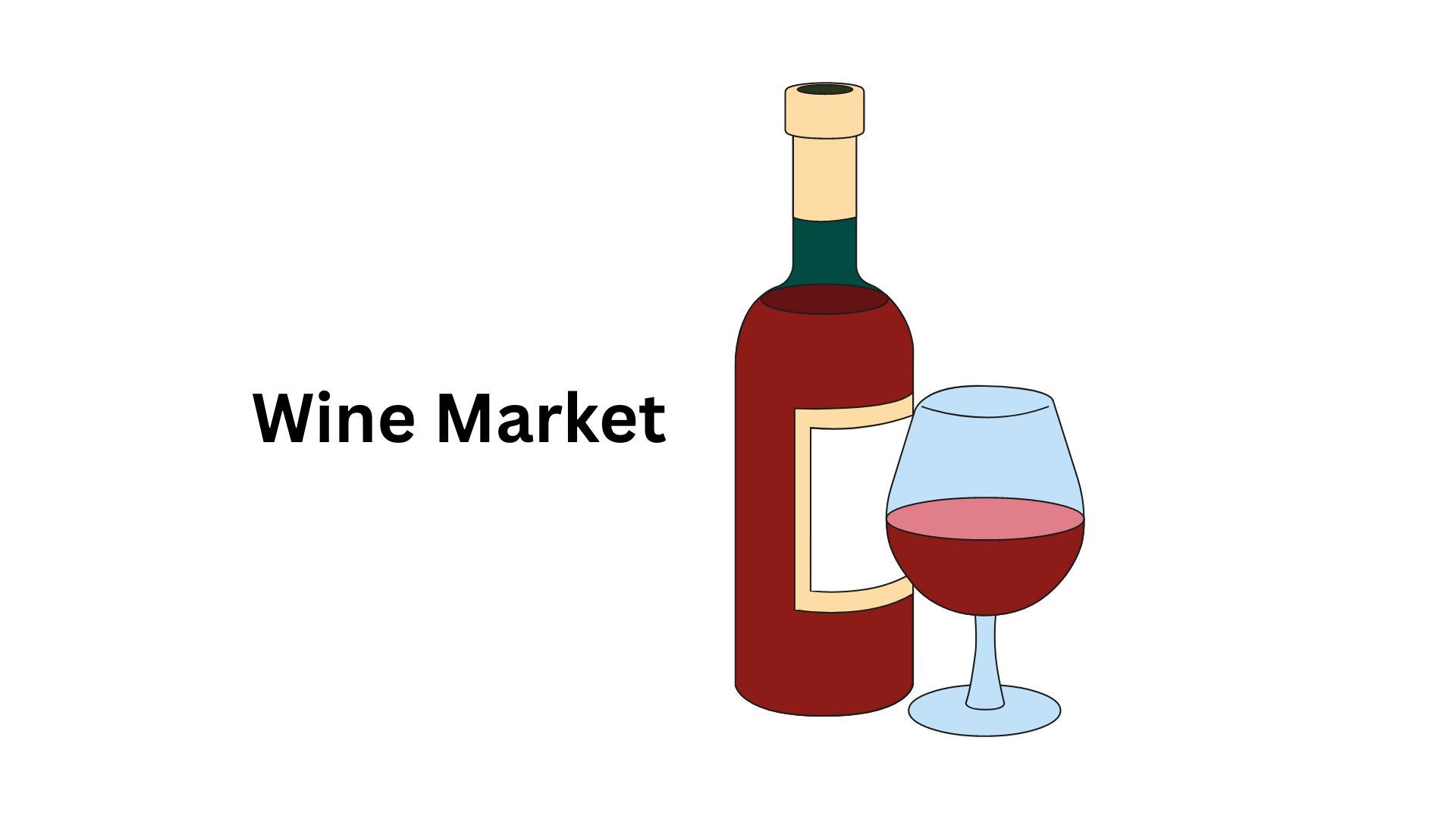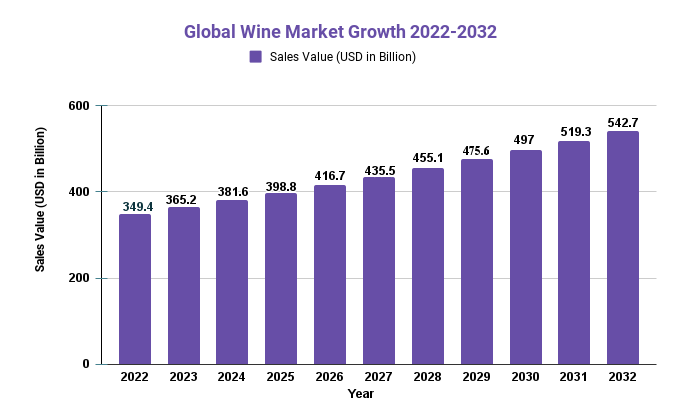Wine Market Size will Observe Substantial Growth by 2032 with a CAGR of 4.5%

Page Contents
Market Overview
Published Via 11Press: The Wine Market is a worldwide industry that involves the production, distribution, and sale of wine made from various grape varieties. Wine has become one of the world's most beloved alcoholic beverages and is enjoyed in nearly every country. The market can be segmented based on factors such as grape type, color, region, and price point.
In 2022, the global wine market was valued at USD 349.4 billion and is forecast to reach a value of USD 542 billion by 2032, rising at an annual compound growth rate (CAGR) of 4.5% from 2022-2032.
This growth can be attributed to factors such as increasing demand for wine from emerging economies, an increasing consumer preference for premium and high-quality wines, and the growing adoption of wine during social gatherings and celebrations.
The market is dominated by several major players, such as E&J Gallo Winery, Constellation Brands, Treasury Wine Estates and Accolade Wines. These businesses boast a strong global presence and offer an extensive range of wine types and brands to cater to different consumer preferences and tastes.
Distribution channels: Retail stores such as supermarkets and liquor stores remain dominant in the market. However, online sales are growing increasingly popular among consumers due to the convenience of purchasing wine online.

Drivers, trends, and challenges have an impact on market dynamics, which can impact businesses. Request for PDF sample report
Key Takeaways
- The global wine market is expected to grow at a CAGR of 4.5% during the forecast period of 2022-2032.
- The demand for organic and natural wines is increasing, driven by consumer preferences for healthier and sustainable products.
- E-commerce and online sales channels are becoming increasingly important for wine sales, especially during the COVID-19 pandemic.
- Asia-Pacific is expected to be the fastest-growing region in the wine market, driven by rising disposable incomes and changing consumer preferences in countries such as China and India.
Regional Snapshot
- Europe is the largest market for wine, accounting for more than 60% of global production and consumption. France, Italy, and Spain are the top wine-producing countries in Europe.
- North America is the second-largest market for wine, with the United States being the largest wine-consuming country in the world.
- Asia-Pacific is expected to be the fastest-growing region for wine, driven by rising disposable incomes and changing consumer preferences. China is the largest wine-consuming country in Asia-Pacific, followed by Japan and South Korea.
- Latin America and the Middle East & Africa are relatively small markets for wine, but they are expected to grow at a steady pace during the forecast period. Argentina and Chile are the top wine-producing countries in Latin America, while South Africa is the largest wine-producing country in the Middle East & Africa region.
Drivers
- Shifting consumer preferences towards wine consumption due to growing awareness of the health benefits associated with moderate wine drinking.
- Growth in demand for organic and natural wines as consumers become more environmentally aware and prioritize sustainable lifestyle choices.
- With increasing disposable incomes and an uptick in premium and luxury wine brands, more consumers are opting for these labels.
- Wine tourism has seen a resurgence as more people visit wine-producing regions for tasting sessions and related experiences.
- The growth of e-commerce and online sales channels offers consumers convenience and accessibility.
Restraints
- High taxes and regulatory barriers in certain countries can limit the growth of the wine market.
- Volatility in grape harvests due to climatic changes may cause fluctuations in wine prices as well as disrupt supply chains.
- Alternative products, such as beer and spirits, may affect the demand for wine.
- Restrictions on alcohol consumption due to cultural or religious reasons may limit growth in certain regions.
- The COVID-19 pandemic has caused widespread disruptions to the wine supply chain, impacting production and distribution.
Opportunities
- Rising demand for premium and luxury wines, as consumers are willing to pay more for high-quality and unique wine products.
- Increased popularity of wine tourism provides wineries with an opportunity to increase their sales through direct-to-consumer channels.
- The proliferation of e-commerce and online sales channels offers consumers convenience and accessibility, opening up new markets for wine producers.
- The growing appeal of wine among younger generations, who are becoming more interested in its culture and willing to try different varieties and brands.
- Furthermore, rising awareness about the health benefits associated with moderate wine drinking could potentially further expand the market for wine products.
Challenges
- Wine market growth could be limited due to competition from other alcoholic beverages, such as beer and spirits, which could increase the costs of production and restrict the availability of wine products. Some countries also impose high taxes and regulatory barriers that could increase the costs of production while restricting wine product access.
- Climate-induced fluctuations in grape harvest can cause supply chain disruptions and alter the availability and pricing of wine products.
- Due to cultural or religious reasons, some regions have put restrictions on alcohol consumption that could hinder growth in the wine market there.
- Health concerns related to excessive alcohol consumption also influence consumer perception and consumption patterns when it comes to wine.
Recent Developments
- Treasury Wine Estates, one of the world's largest wine producers, announced in February 2021 that it may sell some of its lower-priced brands in order to focus on premium and luxury wines.
- Vinventions, a global wine closure solutions provider, recently unveiled its newest wine closure that utilizes sustainable materials and reduces the carbon footprint of wine packaging.
- In April 2021, E. & J. Gallo Winery, the largest family-owned winery in the world, announced their acquisition of more than 30 wine and spirit brands from Constellation Brands, including popular labels like Clos du Bois and Black Box.
- Accolade Wines, one of the world's largest wine producers, announced in May 2021 that it was considering an initial public offering (IPO) to raise funds for future growth and expansion.
- In June 2021, the European Union and the United States reached an agreement to suspend tariffs on wine and other products as part of a settlement of their long-running trade dispute over subsidies to aircraft manufacturers.
Key Market Segments
Type
- Price below 20 USD
- Price 20-50 USD
- Price over 50 USD
Application
- Retail Market
- Auction Sales
Key Market Players
- E&J Gallo
- The Wine Group
- Constellation Brands
- Castel
- Accolade Wines
- Cantine Riunite & CIV
- Concha y Toro
- Treasury Wine Estates
- Grupo Penaflor
- Pernod-Ricard
- Bronco Wine
- Caviro
- Trinchero Family Estates
- Antinori
- Changyu
- Casella Family Brands
- Diageo
- China Great Wall Wine
- Jacob’s Creek
- Kendall-Jackson Vineyard Estates
Report Scope
| Report Attribute | Details |
| The market size value in 2022 | USD 349.4 Bn |
| Revenue forecast by 2032 | USD 542.7 Bn |
| Growth Rate | CAGR Of 4.5% |
| Regions Covered | North America, Europe, Asia Pacific, Latin America, and Middle East & Africa, and Rest of the World |
| Historical Years | 2017-2022 |
| Base Year | 2022 |
| Estimated Year | 2023 |
| Short-Term Projection Year | 2028 |
| Long-Term Projected Year | 2032 |
Frequently Asked Questions
Q: What is the global market size of the wine market?
A: global Wine Market was valued at USD 349.4 billion in 2022 and is expected to reach USD 542.7 billion by 2032, growing at a CAGR of 4.5% from 2022 to 2032.
Q: What are the key factors driving the growth of the wine market?
A: The key factors driving the growth of the wine market include changing consumer preferences towards wine consumption, growing demand for organic and natural wines, increasing disposable incomes, and growing popularity of wine tourism.
Q: What are the major challenges faced by the wine market?
A: The major challenges faced by the wine market include competition from other alcoholic beverages, high taxes, and regulatory barriers, fluctuations in grape harvests, restrictions on alcohol consumption, and health concerns related to excessive alcohol consumption.
Q: Which region is expected to be the fastest-growing market for wine?
A: Asia-Pacific is expected to be the fastest-growing market for wine, driven by rising disposable incomes and changing consumer preferences in countries such as China and India.
Q: What are the opportunities in the wine market?
A: The opportunities in the wine market include increasing demand for premium and luxury wines, the growing popularity of wine tourism, and the rise of e-commerce and online sales channels.
The team behind market.us, marketresearch.biz, market.biz and more. Our purpose is to keep our customers ahead of the game with regard to the markets. They may fluctuate up or down, but we will help you to stay ahead of the curve in these market fluctuations. Our consistent growth and ability to deliver in-depth analyses and market insight has engaged genuine market players. They have faith in us to offer the data and information they require to make balanced and decisive marketing decisions.



